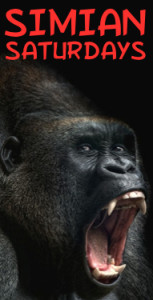 Welcome to the first installment of Simian Saturdays, a series of reviews I’m writing that will examine the movies (and other media) that focused on King Kong, the giant monkey who’s captured generations of monster fans’ hearts over the course of eight decades. It’s part of our countdown to the March 7 release of King Kong, the next addition to our Illustrated Classics library.
Welcome to the first installment of Simian Saturdays, a series of reviews I’m writing that will examine the movies (and other media) that focused on King Kong, the giant monkey who’s captured generations of monster fans’ hearts over the course of eight decades. It’s part of our countdown to the March 7 release of King Kong, the next addition to our Illustrated Classics library.
King Kong is an e-book exclusive that will reintroduce monster fans to the 1932 novelization of the original movie classic. Written by Delos W. Lovelace, based on the story by Edgar Wallace and Merian C. Cooper and the screenplay by James A. Creelman and Ruth Rose, it includes scenes that didn’t appear in the final cut of the film—including the notorious “spider pit” sequence in which Kong’s human pursuers are attacked by horrific arachnids and insects. Our version features six original black-and-white illustrations by comic artist Paul Tuma, whose pulp-influenced style has appeared in the pages of The Twilight Avenger, Flare, and Dan Turner: Hollywood Detective.
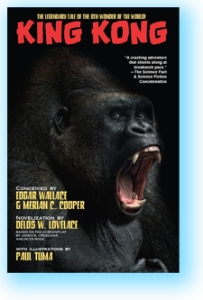 Not familiar with the beauty-and-the-beast story of Kong and his “love interest,” Ann Darrow (who was played in the 1933 original by the queen of the scream queens, Fay Wray)? Well, here’s our edition’s back-cover copy to bring you up-to-date:
Not familiar with the beauty-and-the-beast story of Kong and his “love interest,” Ann Darrow (who was played in the 1933 original by the queen of the scream queens, Fay Wray)? Well, here’s our edition’s back-cover copy to bring you up-to-date:
Ann Darrow was a down-on-her-luck actress struggling to survive in Depression-era New York when she met moviemaker Carl Denham. He offered her the starring role in his latest film: a documentary about a long-lost island—and the godlike ape named Kong rumored to live there. Denham needed a beauty as a counterpart to the beast he hoped to find, and Ann was the answer to his prayers.
Mystery, romance, a chance to turn her life around, even the possibility of stardom—to Ann, it sounded like the adventure of a lifetime! But what she didn’t count on were the horrific dangers that awaited her on Skull Island—including the affections of a love-struck monster . . .
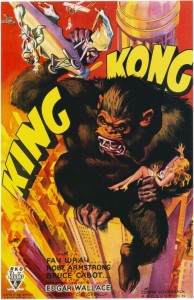 To kick off Simian Saturdays, I figured nothing could be better than to take a look at the movie that launched a monster legend: the original King Kong!
To kick off Simian Saturdays, I figured nothing could be better than to take a look at the movie that launched a monster legend: the original King Kong!
To be completely honest, I have a soft spot in my heart for this version of Kong. It was one of the first horror movies that left a lasting impression on a developing monster kid—others being Bela Lugosi’s Dracula, Boris Karloff’s Frankenstein, and Lon Chaney Jr.’s The Wolfman—and star Fay Wray was my first scream queen (and like the saying goes, you never forget your first scream queen). It was also a movie that, oddly enough, became a staple of New York television broadcasting, running every Thanksgiving (!) on WOR-TV/Channel 9 during the 1970s. (For more about this weird annual tradition, check out this article at DVD Drive-in.)
At face value, Kong has all the pulp-inspired earmarks of a 1930s movie: tough-talking men, a pretty woman who acts self-assured but melts into her romantic lead’s arms at the first sign of danger, sexism (a ship is no place for a woman—you’re only gonna get in the way!), and racist stereotypes (Charlie the Chinese cook with his mangled English, the only black members of the cast being the “savages” who inhabit Skull Island). And Lord knows there’s a good-sized info dump right at the start: who Carl Denham is; the mysterious, potentially dangerous film expedition he’s set up; the fact no agent in New York will provide him with an actress for this project, so he’s got to find one himself (“even if I have to marry one!”). But in spite of those things, Kong remains an enjoyable, fast-paced film.
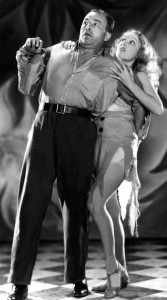
Robert Armstrong and Fay Wray in a publicity photo for King Kong.
A lot of that has to do with the performances of Wray as Ann Darrow and Robert Armstrong as Carl Denham. When she isn’t screaming in terror—which she does way too often—Wray presents Ann as the plucky heroine who hints at a tragic background (out of work, starving, no family) but who’s eager for the chance of adventure. Unfortunately, that aspect of Ann’s character disappears once Kong arrives on the scene, forcing her into the role of swooning damsel in distress for the remainder of the picture. In fact, except for screams and whimpers, Ann (when she’s onscreen and conscious) doesn’t have a word of dialogue from the time she’s kidnapped by the natives until she’s rescued by love interest Jack Driscoll—a forty-minute chunk right in the middle of the film! As for Armstrong, his Denham is brash and loud and just a hair short of scenery chewing—the closest modern parallel I can think of is J.K. Simmons’s memorable portrayal of newspaper editor J. Jonah Jameson in director Sam Raimi’s Spider-Man trilogy. Except ol’ JJJ never shot a stegosaurus in the head at point-blank range with an elephant gun, the way Denham does! There’s also another level to Armstrong’s performance—in Denham, he’s basically playing a composite of Kong’s two directors: creator/producer Merian C. Cooper and Ernest Schoedsack, both of whom were showmen and adventurers in their own right.
What I found really interesting in this rewatch was that, for all the harping Denham does on his “beauty and the beast” love-affair theme—subsequently expanded on in the 1976 and 2005 remakes, in which both Jessica Lange and Naomi Watts fall in love with the big lug—the one person who wants nothing to do with a romantic monster is Ann. Unlike her cinematic descendants, 1930s’ Ann has no love for Kong. She isn’t looking to protect him from biplanes or helicopters—she just wants to get the hell away from him.
For her, the events in King Kong are a living nightmare: she’s kidnapped by the islanders and offered as a sacrifice to their monster god; almost eaten by a T-Rex, an elasmosaur, and a pterodactyl; has her clothes partially torn off by Kong (who even leers and sniffs his fingers after pawing her!); jumps off a cliff to escape him and is then chased by him through the jungle. And after Kong is captured and the story shifts to New York, he breaks free, tracks her down, and carries her off to the top of the Empire State Building.
That sounds more like an abusive relationship than a romance, doesn’t it?
Characterizations aside, it’s stop-motion-animation sequences by Willis O’Brien and his team that are the heart of the movie, giving Kong plenty of screen time to menace Ann and battle his enemies. And he does it all in brutal fashion, shoving people in his mouth and biting down, snapping a T-Rex’s jaws, derailing an elevated train filled with passengers, and throwing a woman from a building. And of course there’s Kong’s climactic showdown with army planes at the top of the Empire State Building—the one scene where you can really feel sorry for the “beast-god” destroyed by civilization. As a whole, it’s an astonishing feat of visual effects that still looks amazing eighty-four years later, especially when compared to the often badly rendered computer-generated digital animation of modern films.
Beyond the adventure and monster shenanigans, there are also humorous moments that involve the sort of snappy one-liners common to movies of this period—as, for example, demonstrated in this exchange between audience members at Kong’s Broadway debut after Denham drags him back to New York City:
Woman: Say, what is it, anyhow?
Man: I hear it’s a kind of a gorilla.
Another man rudely shoves past her. The woman glares at him.
Woman: Gee, ain’t we got enough of them in New York?
If that isn’t an observation of life in the Big Apple that still resonates today, I don’t know what is! 😉
Bottom line? If you’ve never seen the original Kong before, you owe it to yourself to give it a viewing—it’s a classic (monster) movie and a fun time. If you have seen Kong before, break out the popcorn and Raisinets and take another look at it; like me, you might notice things in it you never saw before. And then you can compare it to the upcoming SWC release of Delos Lovelace’s novelization to see how the book differs from the movie!
King Kong (1933)
Starring Fay Wray, Robert Armstrong, and Bruce Cabot
Directed by Ernest B. Schoedsack and Merian C. Cooper
Screenplay by James A. Creelman and Ruth Rose
Story by Edgar Wallace and Merian C. Cooper
Produced by RKO-Pathe Studios
Coming Next Saturday: The disco era is in full swing, and it’s back to Skull Island we go, this time accompanied by Jeff Bridges, Charles Grodin, and Jessica Lange in her big-screen debut, in producer Dino de Laurentiis’s 1976 remake of King Kong. “When the Jaws-a die, nobody cry. When my Kong-a die, ev’rybody cry!” de Laurentiis imitator John Belushi declared in an old Saturday Night Live skit. Let’s see if that’s still true!
King Kong (the SWC Illustrated Classic) goes on sale on March 7, 2017. In the meantime, visit its product page for further information.


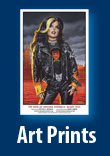




Pingback: Simian Saturdays Looks at the First King Kong | The Saga of Pandora Zwieback
Pingback: Simian Saturdays Climbs the World Trade Center with King Kong 1976 | The Saga of Pandora Zwieback
Pingback: Simian Saturdays: King Kong (2005) | StarWarp Concepts
Pingback: Simian Saturdays Hobbits Along with King Kong 2005 | The Saga of Pandora Zwieback
Pingback: Simian Saturdays: The Handy Recap | StarWarp Concepts
Pingback: King (Kong) of Home Entertainment | StarWarp Concepts
Pingback: Simian Saturdays: King Kong Movie Reviews | StarWarp Concepts